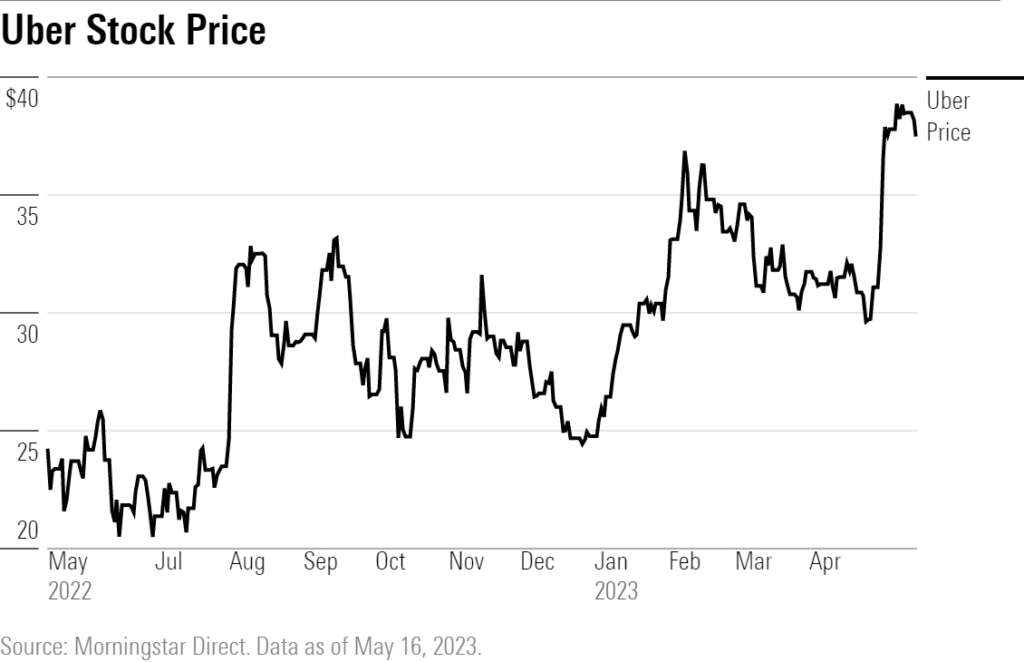The Uber stock forecast has become one of the hottest topics among investors who are eager to understand how the world’s most popular mobility brand will perform in the coming years. Uber Technologies Inc., known globally for transforming transportation, delivery, and logistics, stands at the center of the modern mobility revolution.
Over the past decade, Uber has evolved far beyond ride-hailing. Today, it’s an ecosystem that includes food delivery, freight, and advanced digital mobility. With continuous innovation and expansion, investors are closely watching Uber’s financial future — making the Uber stock forecast a key discussion in both Wall Street and global investment circles.
What Makes Uber Unique in the Global Market
Uber is not just an app; it’s a complete digital platform built around convenience, speed, and efficiency. Founded in 2009 in San Francisco, Uber changed how people move within cities. It made transportation simple and accessible, connecting riders with drivers through a few taps.
Today, Uber operates in over 70 countries and 10,000 cities, offering services like:
- Uber Rides (traditional ride-hailing)
- Uber Eats (food and grocery delivery)
- Uber Freight (logistics and shipment solutions)
- Uber for Business (corporate transport management)
The company’s continuous expansion and innovation are the backbone of a positive Uber stock forecast. It’s not just a transportation firm — it’s a tech-driven mobility giant shaping the future of how goods and people move.
Uber’s Financial Performance: A Shift Toward Profitability
For years, Uber was known for massive growth but limited profits. However, things began to change dramatically in 2023, when Uber finally achieved its first-ever operating profit. This was a turning point that boosted investor confidence and strengthened its market value.
Uber’s 2024 revenue crossed $37 billion, showing strong year-over-year growth in both mobility and delivery sectors. Its gross bookings rose significantly, proving that both consumers and businesses rely more than ever on Uber’s services.
The path to profitability plays a central role in the Uber stock forecast. With reduced operational costs, smarter incentive structures, and improved driver-retention programs, Uber is now better positioned for long-term financial stability.
The Competitive Landscape
The mobility and delivery markets are crowded, but Uber continues to lead. Its main competitors include Lyft, DoorDash, and Bolt, among others. However, Uber’s strength lies in its scale, brand trust, and technology-driven operations.
Unlike many rivals, Uber has managed to merge multiple verticals — rides, food, and freight — under a single app. This ecosystem advantage means that once a customer enters Uber’s world, they rarely need another service.
This wide-ranging network gives Uber an edge in user retention, data collection, and operational efficiency, strengthening its position in every Uber stock forecast for the next decade.
Growth Drivers That Shape the Uber Stock Forecast
1. Expanding Delivery Services
Uber Eats has become one of the company’s strongest business arms. It is available in more than 45 countries, providing users with meals, groceries, and convenience store deliveries. Uber Eats continues to grow even after the pandemic boom, proving its consistent demand.
The company’s push into grocery and retail delivery further strengthens this segment. As consumers embrace digital ordering, Uber’s delivery business could soon rival or surpass its ride-hailing revenue — a major bullish signal for the Uber stock forecast.
2. Uber Freight: The Hidden Gem
Uber Freight connects carriers and shippers through a digital platform, making logistics faster and more transparent. This division is often overlooked, but it’s becoming a significant growth driver.
In a world increasingly dependent on e-commerce, Uber Freight’s role will expand. Analysts predict that it could add billions in yearly revenue within the next few years, positively impacting the Uber stock forecast.
3. Global Expansion and Market Penetration
Emerging markets such as India, Brazil, and Southeast Asia are critical for Uber’s next phase of growth. The company’s adaptable model allows it to tailor prices and services for each region, ensuring continued market share growth.
By entering more developing economies, Uber not only increases user volume but also creates new revenue opportunities that enhance long-term investor confidence.
Technological Innovation: The Heart of Uber’s Strategy
Uber is a technology-first company. Its continuous investment in AI, automation, and data analytics ensures smarter operations and customer satisfaction.
The firm uses advanced algorithms to predict demand, optimize routes, and improve driver-passenger matches. Additionally, Uber’s move toward autonomous vehicles through partnerships with Aurora and other tech leaders could redefine the entire ride-hailing industry.
If successful, automation could significantly reduce costs, improve safety, and increase profit margins — a game-changer for the Uber stock forecast over the next 5–10 years.
Sustainability and Environmental Vision
Uber’s pledge to achieve zero emissions by 2040 is a strategic and responsible decision. The company is actively promoting electric vehicle adoption by offering incentives to EV drivers and investing in charging infrastructure.
This focus on sustainability not only supports global environmental goals but also attracts eco-conscious investors and users. As governments tighten emissions laws, Uber’s early leadership in this space could secure its long-term market dominance.
A green and efficient business model is now central to every positive Uber stock forecast.
Uber Stock Forecast 2025–2030: What Analysts Predict
Most financial experts see Uber’s stock climbing steadily over the next few years. Analysts from Goldman Sachs, JP Morgan, and Morgan Stanley have released bullish projections, placing Uber’s 2025 price target between $80–$100 per share, up from its current range.
For the 2030 outlook, analysts suggest Uber could potentially double in value if the company maintains profitability, scales its delivery arm, and executes its autonomous vehicle plans effectively.
These estimates are supported by strong fundamentals — consistent revenue growth, improving margins, and solid cash flow. If Uber continues this trajectory, the Uber stock forecast points toward long-term upward momentum.

Challenges and Risks Investors Should Watch
While Uber’s outlook is promising, investors should remain cautious about potential risks. Regulatory issues remain one of the biggest challenges, especially regarding driver classification and labor laws in the U.S. and Europe.
Fuel price fluctuations, global inflation, and economic slowdowns could also impact demand for ride-hailing and delivery. Additionally, growing competition from regional mobility apps may pressure market share in some regions.
However, Uber’s diversified structure and global brand help mitigate many of these threats. Its adaptability remains a strong advantage for maintaining a favorable Uber stock forecast even in uncertain conditions.
Investor Sentiment and Market Confidence
Uber’s improved financial discipline and steady profitability have changed how investors view the company. Once considered a high-risk tech startup, Uber is now seen as a sustainable technology leader with long-term growth potential.
Institutional investors have increased their holdings in Uber since 2023, signaling strong confidence in its management and strategic direction. Market sentiment on Wall Street has turned notably positive, with many analysts recommending Buy or Strong Buy ratings.
Such positive market confidence further strengthens the Uber stock forecast, especially as Uber continues to expand its ecosystem of integrated services.
Global Economic Factors Affecting Uber’s Performance
Uber operates in a highly globalized industry, meaning its performance is linked closely to global economic health. Factors like inflation, interest rates, and fuel prices can influence both costs and consumer spending habits.
However, Uber’s diversified portfolio — from mobility to freight — helps it balance regional weaknesses. In developing economies, for instance, low-cost services keep ride demand stable even during economic downturns.
As more countries invest in urban mobility infrastructure and e-commerce, Uber’s role will continue to grow, supporting a long-term optimistic Uber stock forecast.
Is Uber a Smart Investment in 2025?
Investors looking for a blend of technology, innovation, and real-world utility will find Uber highly attractive. Its presence across multiple industries reduces dependency on any single revenue source, creating long-term financial resilience.
With solid management, increasing profitability, and continuous innovation, Uber is transitioning from a disruptive startup to a mature and profitable global enterprise. The combination of stable revenue streams and expansion potential makes Uber a strong candidate for future-focused investors.
For those building a diversified portfolio, the Uber stock forecast suggests significant upside potential over the next five years.
Conclusion
The Uber stock forecast represents a story of transformation — from a loss-making disruptor to a profitable, innovation-driven global leader. With powerful growth engines in ride-hailing, delivery, and freight, Uber is shaping the future of transportation and logistics worldwide.
Although the journey involves challenges, Uber’s technological edge, sustainability goals, and strong financial turnaround make it one of the most promising long-term investments in the tech sector.
As global markets evolve, Uber’s adaptability, innovation, and strategic vision are likely to keep driving both growth and investor confidence in the years ahead.
FAQs
1. What is the Uber stock forecast for 2025?
Experts expect Uber’s stock to range between $80 and $100 by 2025 if growth continues.
2. Is Uber currently profitable?
Yes, Uber achieved operating profitability in 2023 and continues to strengthen margins.
3. What are the main risks for Uber investors?
Regulations, competition, and global economic slowdowns are the key risks.
4. Why is Uber stock popular among investors?
Because of its innovation, diversified services, and strong long-term growth potential.
5. Is Uber stock a good buy for long-term investors?
Yes, many analysts consider Uber a strong long-term investment due to consistent revenue and global expansion.
Read Also : Marilyn Kroc Barg: The Untold Daughter Behind the McDonald’s Empire

